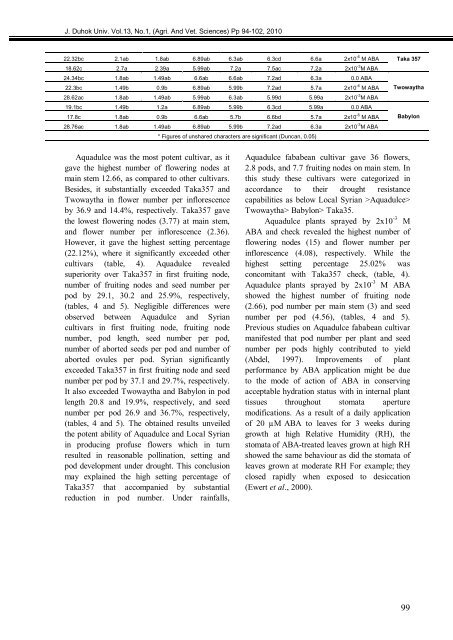The Influence Of Priming Two Cucumber Cultivar Seeds
The Influence Of Priming Two Cucumber Cultivar Seeds
The Influence Of Priming Two Cucumber Cultivar Seeds
You also want an ePaper? Increase the reach of your titles
YUMPU automatically turns print PDFs into web optimized ePapers that Google loves.
J. Duhok Univ. Vol.13, No.1, (Agri. And Vet. Sciences) Pp 94-102, 2010<br />
22.32bc<br />
18.62c<br />
24.34bc<br />
22.3bc<br />
28.62ac<br />
19.1bc<br />
17.8c<br />
28.76ac<br />
2.1ab<br />
2.7a<br />
1.8ab<br />
1.49b<br />
1.8ab<br />
1.49b<br />
1.8ab<br />
1.8ab<br />
1.8ab<br />
2.39a<br />
1.49ab<br />
0.9b<br />
1.49ab<br />
1.2a<br />
0.9b<br />
1.49ab<br />
6.89ab<br />
5.99ab<br />
6.6ab<br />
6.89ab<br />
5.99ab<br />
6.89ab<br />
6.6ab<br />
6.89ab<br />
Aquadulce was the most potent cultivar, as it<br />
gave the highest number of flowering nodes at<br />
main stem 12.66, as compared to other cultivars.<br />
Besides, it substantially exceeded Taka357 and<br />
<strong>Two</strong>waytha in flower number per inflorescence<br />
by 36.9 and 14.4%, respectively. Taka357 gave<br />
the lowest flowering nodes (3.77) at main stem,<br />
and flower number per inflorescence (2.36).<br />
However, it gave the highest setting percentage<br />
(22.12%), where it significantly exceeded other<br />
cultivars (table, 4). Aquadulce revealed<br />
superiority over Taka357 in first fruiting node,<br />
number of fruiting nodes and seed number per<br />
pod by 29.1, 30.2 and 25.9%, respectively,<br />
(tables, 4 and 5). Negligible differences were<br />
observed between Aquadulce and Syrian<br />
cultivars in first fruiting node, fruiting node<br />
number, pod length, seed number per pod,<br />
number of aborted seeds per pod and number of<br />
aborted ovules per pod. Syrian significantly<br />
exceeded Taka357 in first fruiting node and seed<br />
number per pod by 37.1 and 29.7%, respectively.<br />
It also exceeded <strong>Two</strong>waytha and Babylon in pod<br />
length 20.8 and 19.9%, respectively, and seed<br />
number per pod 26.9 and 36.7%, respectively,<br />
(tables, 4 and 5). <strong>The</strong> obtained results unveiled<br />
the potent ability of Aquadulce and Local Syrian<br />
in producing profuse flowers which in turn<br />
resulted in reasonable pollination, setting and<br />
pod development under drought. This conclusion<br />
may explained the high setting percentage of<br />
Taka357 that accompanied by substantial<br />
reduction in pod number. Under rainfalls,<br />
6.3ab<br />
7.2a<br />
6.6ab<br />
5.99b<br />
6.3ab<br />
5.99b<br />
5.7b<br />
5.99b<br />
6.3cd<br />
7.5ac<br />
7.2ad<br />
7.2ad<br />
5.99d<br />
6.3cd<br />
6.6bd<br />
7.2ad<br />
* Figures of unshared characters are significant (Duncan, 0.05)<br />
6.6a<br />
7.2a<br />
6.3a<br />
5.7a<br />
5.99a<br />
5.99a<br />
5.7a<br />
6.3a<br />
2x10 -6 M ABA<br />
2x10 -3 M ABA<br />
0.0 ABA<br />
2x10 -6 M ABA<br />
2x10 -3 M ABA<br />
0.0 ABA<br />
2x10 -6 M ABA<br />
2x10 -3 M ABA<br />
Taka 357<br />
<strong>Two</strong>waytha<br />
Babylon<br />
Aquadulce fababean cultivar gave 36 flowers,<br />
2.8 pods, and 7.7 fruiting nodes on main stem. In<br />
this study these cultivars were categorized in<br />
accordance to their drought resistance<br />
capabilities as below Local Syrian >Aquadulce><br />
<strong>Two</strong>waytha> Babylon> Taka35.<br />
Aquadulce plants sprayed by 2x10 -3 M<br />
ABA and check revealed the highest number of<br />
flowering nodes (15) and flower number per<br />
inflorescence (4.08), respectively. While the<br />
highest setting percentage 25.02% was<br />
concomitant with Taka357 check, (table, 4).<br />
Aquadulce plants sprayed by 2x10 -3 M ABA<br />
showed the highest number of fruiting node<br />
(2.66), pod number per main stem (3) and seed<br />
number per pod (4.56), (tables, 4 and 5).<br />
Previous studies on Aquadulce fababean cultivar<br />
manifested that pod number per plant and seed<br />
number per pods highly contributed to yield<br />
(Abdel, 1997). Improvements of plant<br />
performance by ABA application might be due<br />
to the mode of action of ABA in conserving<br />
acceptable hydration status with in internal plant<br />
tissues throughout stomata aperture<br />
modifications. As a result of a daily application<br />
of 20 µM ABA to leaves for 3 weeks during<br />
growth at high Relative Humidity (RH), the<br />
stomata of ABA-treated leaves grown at high RH<br />
showed the same behaviour as did the stomata of<br />
leaves grown at moderate RH For example; they<br />
closed rapidly when exposed to desiccation<br />
(Ewert et al., 2000).<br />
44



